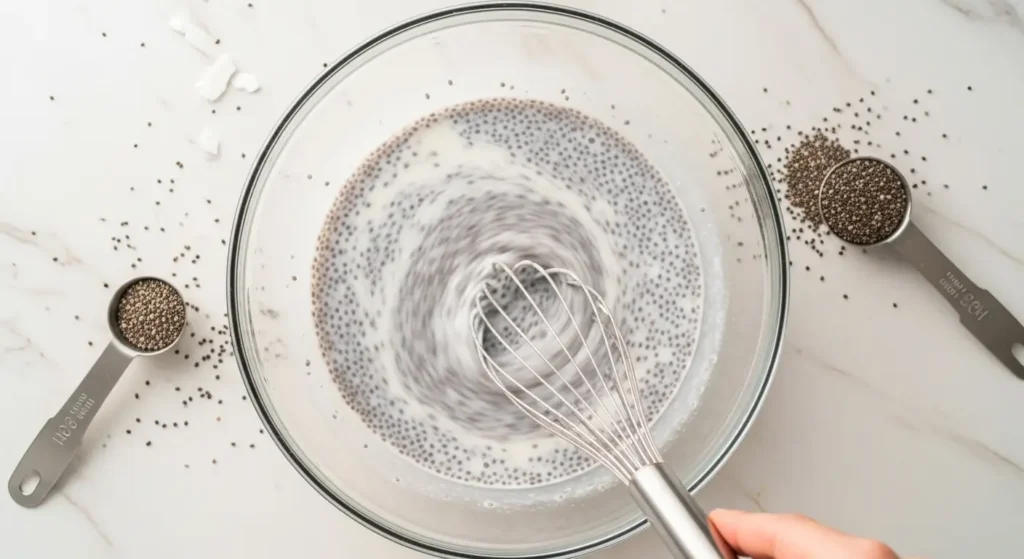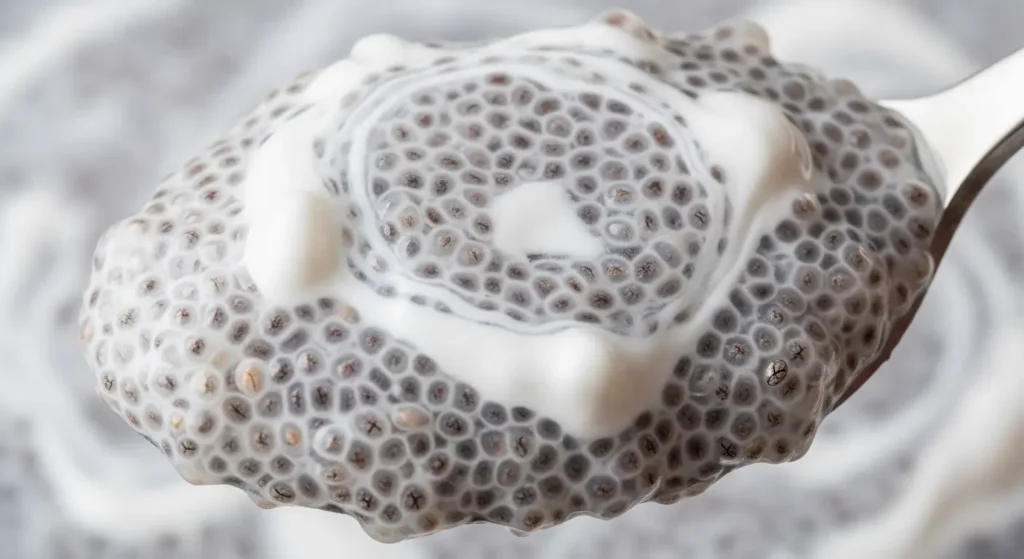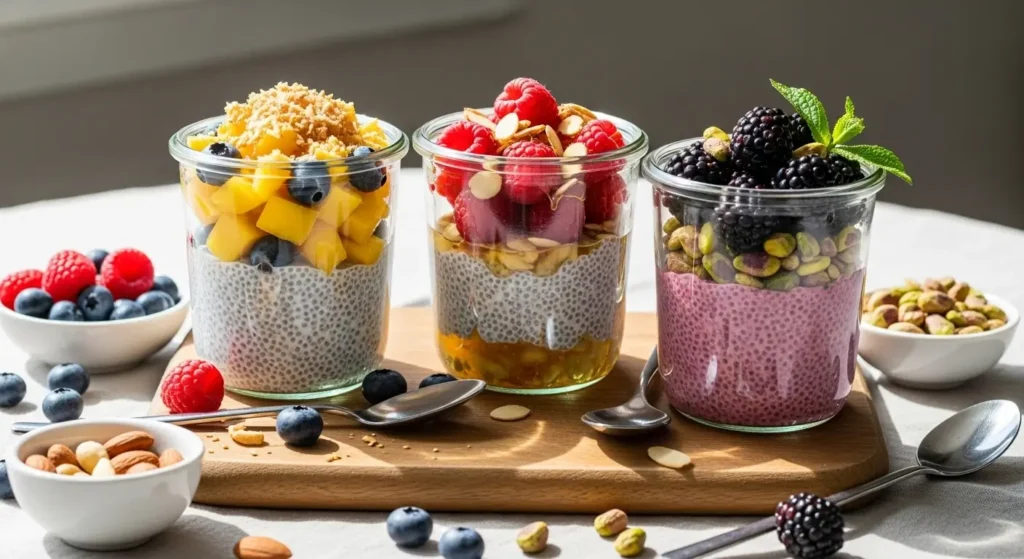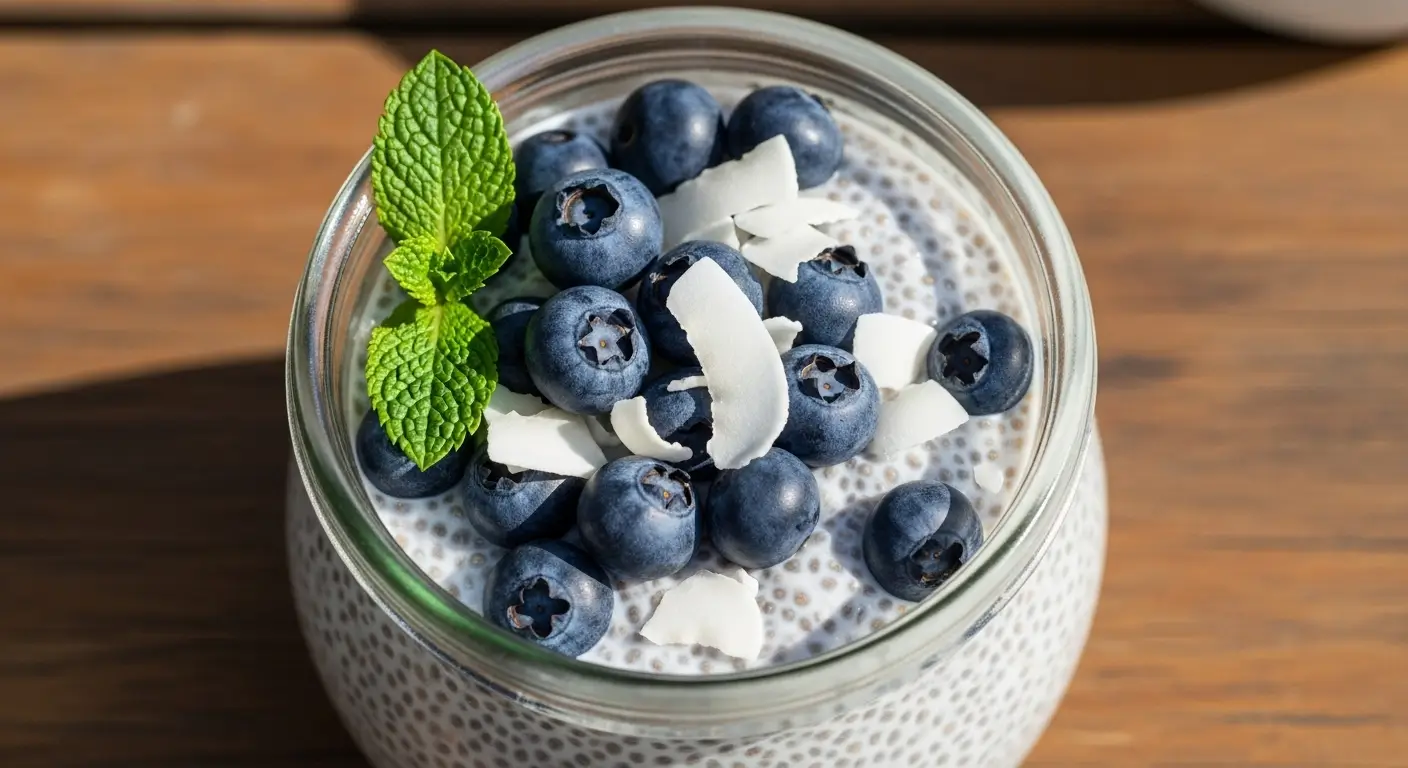Chia Seed Coconut Milk Pudding – The Ultimate Creamy Superfood Dessert
When it comes to healthy, easy, and satisfying treats, chia seed coconut milk pudding stands out as a true winner. With just a few ingredients, you can whip up a creamy, plant-based pudding that’s rich in fiber, omega-3s, and healthy fats. It’s perfect for breakfast, a post-workout snack, or even dessert.
This guide will show you how to make the perfect chia pudding, explain why it’s so nutritious, and share pro tips for soaking, mixing, and flavoring. We’ll also cover common questions like the best chia-to-coconut milk ratio, what not to mix with chia seeds, and how much is safe to eat daily.
Learn more about healthy dairy-free options in our guide on how to make coconut milk.
Table of Contents
What Is Chia Seed Coconut Milk Pudding?
A Modern Take on a Classic Healthy Dessert
Chia pudding isn’t new—it’s inspired by ancient Aztec and Mayan traditions, where chia seeds were prized for energy and endurance. When combined with coconut milk, the tiny seeds expand into a creamy, custard-like pudding that’s both delicious and nutritious.
It’s a simple mix of chia seeds, coconut milk, and a touch of sweetener—no cooking required. Just soak, stir, and chill.
How Chia Seeds and Coconut Milk Work Together for Creaminess
When chia seeds absorb liquid, they form a natural gel due to soluble fiber. Coconut milk adds richness and flavor, creating that velvety texture people love. The combination is naturally gluten-free, vegan, and paleo-friendly.
Check out another creamy favorite like kefir chia seed pudding for more superfood inspiration.
The Rise of Dairy-Free and Plant-Based Puddings
The popularity of chia pudding exploded thanks to the growing demand for plant-based breakfasts and desserts. Whether you’re avoiding dairy, cutting sugar, or just want a lighter meal prep idea, this pudding checks every box.
Looking for inspiration? Try our peanut butter overnight oats for another simple, protein-packed start to your day.
Why Chia Pudding with Coconut Milk Is Incredibly Healthy
Nutritional Benefits of Chia Seeds
Chia seeds might be tiny, but they’re nutritional powerhouses. Each spoonful packs omega-3 fatty acids, fiber, protein, calcium, and antioxidants—all in one bite. The high fiber content keeps you full longer, making chia pudding an excellent choice for weight management and gut health.
Plus, chia seeds contain all nine essential amino acids, making them a complete plant-based protein. That’s why fitness enthusiasts and wellness lovers often enjoy chia seed coconut milk pudding as a post-workout recovery snack.
The Health Perks of Coconut Milk
Coconut milk doesn’t just add creaminess—it brings along healthy fats known as medium-chain triglycerides (MCTs). These fats can help increase energy, support brain function, and may even promote fat burning. It’s also naturally lactose-free, which makes it a great dairy substitute for those with sensitivities.
Want to learn about more energizing drink ideas? Don’t miss our homemade energy drink recipe for a refreshing boost.
Combining Superfoods for a Balanced Treat
When chia seeds and coconut milk come together, they form a balanced blend of fiber, fat, and protein—keeping blood sugar levels steady and energy consistent. Unlike sugary puddings, this one nourishes your body without the crash.
You can also mix in other nutrient-rich ingredients like berries, cacao, or almond butter for extra antioxidants and flavor variety.
If you love nutritious, indulgent treats, try our healthy apple crumble recipe next—it’s a comforting, wholesome dessert that complements your chia pudding routine.
The Perfect Chia Seeds to Coconut Milk Ratio
Standard Ratios for Creamy Texture
Getting the right texture in chia seed coconut milk pudding depends on one simple rule: the ratio of liquid to chia seeds.
The classic formula is 3 tablespoons of chia seeds for every 1 cup of coconut milk. This creates a smooth, pudding-like consistency that’s thick but spoonable.
If you prefer a thinner texture—great for smoothies or breakfast bowls—use 2 tablespoons of chia seeds instead. For a thicker dessert-like pudding, go up to 4 tablespoons per cup of milk.
Here’s a quick guide:
| Texture Preference | Chia Seeds | Coconut Milk | Result |
|---|---|---|---|
| Light & Drinkable | 2 tbsp | 1 cup | Smooth & thin |
| Creamy Classic | 3 tbsp | 1 cup | Perfect pudding |
| Thick & Dense | 4 tbsp | 1 cup | Spoonable dessert |
Adjusting Ratios for Thickness or Lightness
The type of coconut milk you use also matters. Full-fat coconut milk makes your pudding rich and velvety, while light coconut milk or boxed coconut beverages yield a lighter texture.
For a balanced option, try half full-fat and half light coconut milk. This combo gives you creaminess without feeling too heavy.
Discover great ideas like arroz con leche, another creamy comfort dessert made simple.
Common Mistakes in Measuring and Mixing
One of the most common issues is clumping—chia seeds sticking together instead of absorbing liquid evenly. The fix? Stir twice: once right after mixing, and again 10 minutes later. This ensures every seed gets hydrated.
Avoid adding chia seeds to cold coconut milk straight from the fridge; room-temperature milk helps them expand evenly.
Once your pudding sets, taste it before chilling overnight—it thickens as it cools, so aim for slightly looser than your desired texture.

Step-by-Step Recipe – How to Make Chia Seed Coconut Milk Pudding
Ingredients You’ll Need
Creating this creamy, healthy dessert takes only a few simple ingredients. Here’s your base recipe for one large serving or two smaller portions:
| Ingredient | Quantity | Notes |
|---|---|---|
| Chia seeds | 3 tbsp | Whole black or white chia seeds |
| Coconut milk | 1 cup | Full-fat or light, as preferred |
| Maple syrup or honey | 1–2 tsp | Adjust sweetness to taste |
| Vanilla extract | ½ tsp | Optional, for flavor depth |
| Salt | Pinch | Balances sweetness |
| Fresh fruit or nuts | For topping | Optional, adds crunch and color |
Optional add-ins: cocoa powder, cinnamon, shredded coconut, or protein powder for a nutrient boost.
Simple Directions for the Perfect Soak
- Combine Ingredients: In a medium bowl or jar, whisk together chia seeds, coconut milk, sweetener, and vanilla extract until evenly mixed.
- Rest and Stir: Let the mixture sit for 10 minutes, then stir again to prevent clumps.
- Chill Overnight: Cover and refrigerate for at least 2 hours or overnight. The pudding will thicken naturally as the seeds absorb the liquid.
- Serve: Give it one last stir before serving and top with fruits, nuts, or a drizzle of honey.
How Long to Chill and Set for the Best Results
For the best texture, chill your chia seed coconut milk pudding for 6–8 hours. This allows the chia seeds to absorb maximum liquid, creating that signature creamy consistency.
If you’re short on time, a 2-hour chill works too—but the flavor deepens overnight.
Don’t miss our mango sticky rice recipe if you love tropical, creamy desserts with similar smoothness.
Tips for Soaking Chia Seeds in Coconut Milk
Best Practices for Even Hydration
Soaking chia seeds properly is the secret to smooth, creamy pudding. Always start by stirring your chia seeds into the coconut milk gradually—don’t dump them all at once. This ensures each seed gets evenly coated and expands without clumping.
Use a whisk or a mason jar with a tight lid and shake vigorously for about 30 seconds. Wait 5–10 minutes, then stir or shake again. This double-mixing technique keeps the texture uniform.
If you like experimenting, you can replace part of the coconut milk with almond milk or oat milk for a lighter flavor twist.

How Long Should You Soak Chia Seeds?
Chia seeds begin absorbing liquid immediately but need at least 2 hours to fully gel. For the creamiest texture, overnight soaking (6–8 hours) is ideal. This resting time lets the fiber soften completely, producing that classic pudding-like consistency.
For busy mornings, prepare several jars at once—they keep fresh in the fridge for up to 4 days.
Don’t miss our overnight oats recipes for another make-ahead breakfast idea that saves time and adds variety.
Avoiding Clumps and Uneven Texture
Clumping usually happens when seeds aren’t stirred enough early on or when added to very cold liquid. Always use room-temperature coconut milk and mix twice.
If your pudding turns out too thick, add a splash of coconut milk and stir before serving. For a smoother dessert, blend the mixture after soaking—it creates a mousse-like texture perfect for layering with fruits or granola.
Looking for more dairy-free desserts? Try our creamy vegan hollandaise sauce—it’s versatile, silky, and complements your plant-based menu beautifully.
Toppings, Flavors, and Variations
Fresh Fruit and Crunchy Add-ons
The beauty of chia seed coconut milk pudding lies in its versatility. Once you’ve nailed the base recipe, it’s easy to dress it up with toppings. Add fresh berries, sliced mango, or kiwi for a tropical punch.
For crunch, sprinkle toasted coconut flakes, almonds, or granola on top. These not only enhance texture but also make your pudding more satisfying and nutrient-dense.
Want to try a refreshing summer twist? Pair your pudding with a spoonful of blueberry syrup for natural sweetness and color.
Flavoring Ideas – Vanilla, Chocolate, and Tropical Twists
You can easily turn your chia pudding into a gourmet treat with a few mix-ins:
- Vanilla Delight: Add ½ teaspoon of pure vanilla extract and a drizzle of maple syrup.
- Chocolate Dream: Mix in 1 tablespoon of cocoa powder for a rich, healthy dessert.
- Tropical Escape: Blend in pineapple puree or mango chunks before chilling.
For an energizing breakfast, stir in espresso or cold brew for a coffee chia pudding variation.
Discover more flavor inspiration in our tropical smoothie ideas.

Meal Prep and Storage Tips
One of the best things about chia pudding is its meal prep potential. Make a big batch, portion it into jars, and store it in the fridge for up to four days. It’s perfect for grab-and-go breakfasts or quick snacks.
If layering toppings like fruit or granola, add them right before eating to keep textures crisp and fresh.
For a creamy upgrade, swirl in yogurt or nut butter just before serving—it balances flavor and adds protein.
What Not to Mix with Chia Seeds
Ingredients That Can Affect Nutrient Absorption
While chia seeds mix well with most foods, a few combinations can reduce their benefits. For instance, adding chia seeds directly to highly acidic liquids like pure lemon juice or vinegar may hinder proper gel formation and reduce fiber absorption.
Similarly, avoid combining chia pudding with too much fiber-heavy food (like flaxseed or bran) in the same meal. Too much fiber at once can cause bloating or stomach cramps, especially for beginners.
Learn more about pairing ingredients correctly in our guide to healthy suhoor ideas.
Combinations That Cause Digestive Discomfort
Chia seeds expand rapidly when they come into contact with liquid. If not pre-soaked properly, they can cause mild choking hazards or digestive discomfort. Always let them sit in coconut milk (or other liquid) until fully hydrated.
Avoid mixing chia seeds into thick, sticky foods like peanut butter without extra liquid—they won’t absorb moisture evenly.
Safe Alternatives for Sensitive Stomachs
If you’re new to chia seeds, start small—1 tablespoon per day—and gradually increase as your body adjusts. You can also mix soaked chia pudding with gentle ingredients like banana, almond butter, or yogurt for easier digestion.
Prefer a fiber-friendly dessert instead? Try our cottage cheese desserts for high protein with less fiber intensity.
Warnings and Precautions – Is There a Limit?
Why There’s a Warning Label on Chia Seeds
If you’ve ever noticed a warning on chia seed packaging, don’t panic—it’s mostly precautionary. The label exists because dry chia seeds expand quickly when exposed to liquid. Eating them dry can pose a choking risk, especially for people with swallowing issues.
That’s why it’s always best to soak chia seeds in coconut milk or another liquid before eating. Proper hydration ensures safe digestion and better nutrient absorption.
Possible Side Effects of Overconsumption
Even healthy foods can cause problems in excess. Eating too much chia pudding may lead to bloating, gas, or constipation, mainly due to its high fiber content.
Most nutrition experts recommend limiting intake to 1–2 tablespoons of chia seeds per meal, which equals one serving of pudding. This amount provides energy and nutrients without overwhelming your digestive system.
Don’t miss our chia seed water guide, which explains how to enjoy chia’s benefits safely in drink form.
How Much Chia Seed Pudding Is Safe Per Day
A safe daily intake for most adults is around 2–3 tablespoons of chia seeds, which translates to roughly one cup of chia seed coconut milk pudding. That’s enough to get fiber, omega-3s, and protein without discomfort.
If you’re increasing your intake, do it gradually and stay hydrated throughout the day. Fiber absorbs water, so drinking plenty helps your body adjust smoothly.
Looking for a low-fiber but protein-rich option? Check out our cottage cheese bagel recipe for a satisfying, balanced breakfast idea.
Conclusion: Why You’ll Love Adding Chia Seed Coconut Milk Pudding to Your Diet
In a world of complex recipes, chia seed coconut milk pudding proves that simple is best. It’s creamy, nourishing, and endlessly customizable—perfect for busy mornings or a guilt-free dessert. With a few pantry staples, you can create a satisfying dish that fuels your body and delights your taste buds.
Don’t miss our delicious healthy frozen yogurt treats for another cooling, nutrient-packed dessert option.
FAQs
Is chia pudding with coconut milk healthy?
Yes! Chia pudding with coconut milk is incredibly healthy. It’s rich in fiber, protein, healthy fats, and antioxidants. The combination supports digestion, heart health, and sustained energy. Plus, it’s dairy-free, gluten-free, and suitable for vegan diets.
What is the ratio of chia seeds to coconut milk?
The best ratio for chia seed coconut milk pudding is 3 tablespoons of chia seeds to 1 cup of coconut milk. This creates the ideal creamy consistency. Adjust slightly based on preference—more seeds for thickness, less for lightness.
Is it okay to soak chia seeds in coconut milk?
Absolutely. Coconut milk is one of the best liquids for soaking chia seeds. It enhances texture, flavor, and nutrient absorption. Soak them for at least 2 hours—or overnight—for the perfect pudding.
What should not mix with chia seeds?
Avoid combining chia seeds with extremely acidic liquids (like vinegar or lemon juice) or eating them dry. Always mix with enough liquid to allow expansion, and stir well to prevent clumping.
Why is there a warning on chia seeds?
The warning exists because dry chia seeds can expand in the throat and cause a choking risk if consumed without soaking. Once hydrated, they’re completely safe and beneficial.
Why is it not good to eat a lot of chia seeds?
Eating too many chia seeds may cause bloating or digestive discomfort due to their high fiber content. Stick to 1–2 tablespoons per meal and drink plenty of water to stay balanced.

